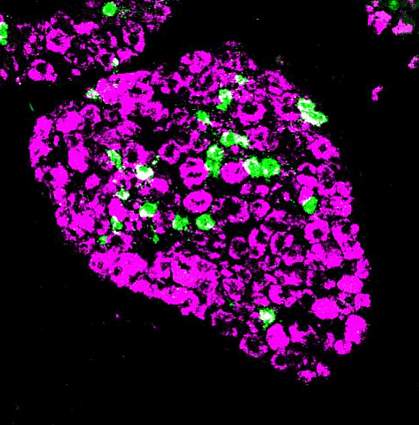You are here
August 13, 2019
Compound reduces chronic itch in mice
At a Glance
- Researchers identified a compound that could reduce itch in mice by blocking a receptor in the spinal cord.
- The compound reduced itch both after exposure to irritating substances and in a model of chronic itch.
- Future studies are needed to develop a drug that could be tested in people.

Chronic itch affects millions of Americans. It occurs in many medical conditions and in response to certain drugs. The condition can be debilitating, and existing medications to treat chronic itch don’t provide reliable relief.
Researchers led by Dr. Mark Hoon from NIH’s National Institute of Dental and Craniofacial Research (NIDCR) have been working to understand itch at the molecular level. In previous studies, they identified a molecule called Nppb that drives itching in mice.
Because Nppb can be found throughout the body, trying to shut it down directly with drugs may not be safe. Additional research from the team identified a receptor for Nppb that is found only in the spinal cord. The receptor, called NPR1, could be a possible target for stopping itch.
In work by other researchers, a compound thought to inhibit NPR1 didn’t alleviate itching in mice. Hoon and his colleagues wanted to better understand why this compound didn’t work as expected, and to search for more powerful inhibitors of NPR1.
The team collaborated with Dr. James Inglese’s group at NIH’s National Center for Advancing Translational Sciences (NCATS) to screen more than 85,000 compounds for potential use in blocking NPR1 and therefore itch. Promising compounds were then tested in mouse models of itch. The results were published on July 10, 2019, in Science Translational Medicine.
The team first found that the drug previously thought to target NPR1 didn’t work as expected. Instead of blocking the receptor’s activity, it partially turned on the receptor.
In their initial screen of the NCATS compounds, the researchers found more than 1,400 that could potentially serve as inhibitors of NPR1. Further studies winnowed that set down to 15 promising candidates.
The researchers chose one of these compounds for further tests in mice. In studies to ensure safety, doses expected to inhibit itch did not show any unwanted effects on mouse behavior or movement. Blood pressure dropped briefly after injection but returned to normal in less than 5 minutes.
Mice were then exposed to histamine, an itch-inducing substance. Those that received the experimental compound before exposure had their scratching responses reduced by more than half. Similar results were seen after exposure to a second itch-inducing substance. The experimental compound also reduced scratching in mice with a chronic itch condition, even though skin inflammation itself was not reduced.
In experiments done to prepare for future work in people, the team found that the nerves in human dorsal root ganglia, which bring information to the spinal cord, contain amounts of Nppb similar to those in mice. NPR1 is also found in similar amounts in human and mouse spinal cord tissue.
“We’ve shown that blocking NPR1 could be a potential approach to treating chronic itch,” Inglese says. “Additional studies are needed to identify and refine a drug that could be safely tested in people.”
Related Links
- Scientists Define Molecule’s Role in Itch and Pain Pathways
- Scientists Discover a Dedicated Pathway for Itch
- Socially Contagious Itching Hardwired into Brain
- Skin Diseases
References: Inhibition of natriuretic peptide receptor 1 reduces itch in mice. Solinski HJ, Dranchak P, Oliphant E, Gu X, Earnest TW, Braisted J, Inglese J, Hoon MA. Sci Transl Med. 2019 Jul 10;11(500). pii: eaav5464. doi: 10.1126/scitranslmed.aav5464. PMID: 31292265.
Funding: NIH’s National Institute of Dental and Craniofacial Research (NIDCR) and National Center for Advancing Translational Sciences (NCATS).
